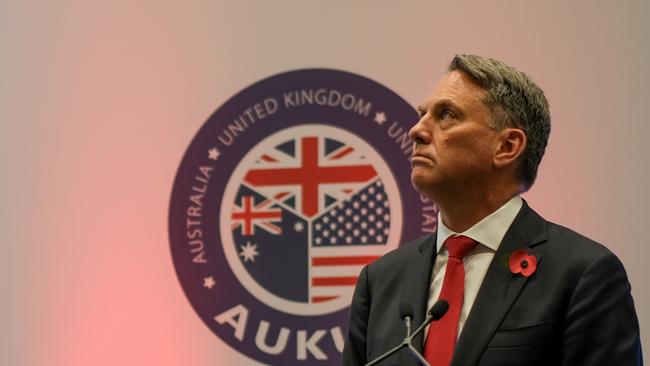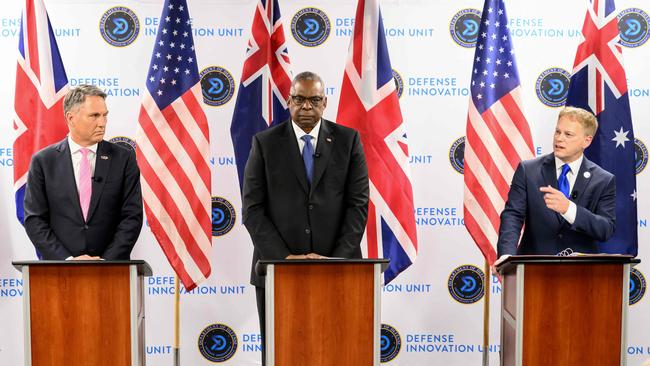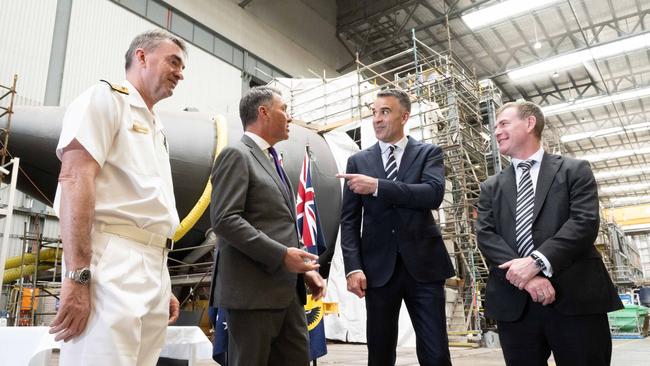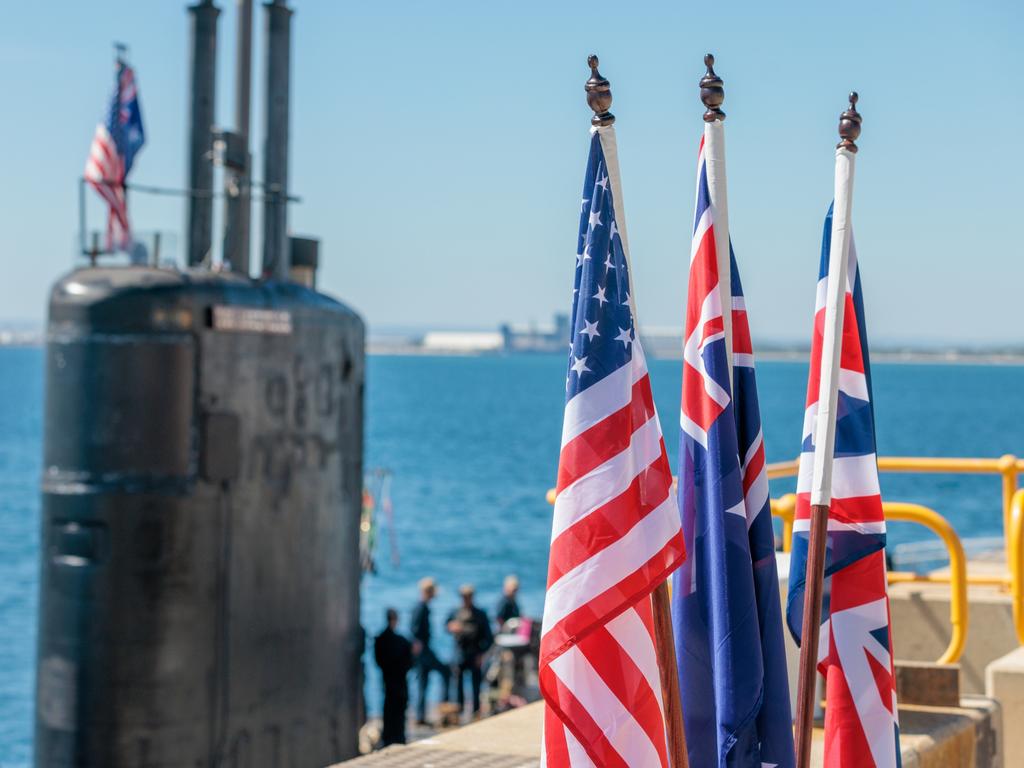
Richard Marles was effusive: in what has been “a truly momentous year” the three countries had made “an enormous amount of progress” achieving nothing less than “a breakthrough moment in terms of Australia’s defence capability.”
Marles was feeling “the need for speed” and nothing less than “a huge leap forward” had been delivered in the last twelve months.
Are you excited yet? Welcome to the burlesque theatre of AUKUS co-operation, where momentous events can be glimpsed – or then again maybe not – through the opaque language of defence media statements.
To recap: AUKUS was announced by then Prime Minister Scott Morrison in September 2021, delivering a pathway for the Australian Navy to acquire nuclear-powered submarines working with their British and American counterparts.

This is a massive step up for Australian defence. Nuclear powered subs have practically unlimited range and endurance, making them ideal for Australia’s strategic needs. But the cost and complexity of the technology is eye-watering.
The Biden administration saw AUKUS as a way to make Australia take a stronger leadership role in Indo-Pacific security. That frankly cuts against decades of Australian free-riding on America’s military presence in Asia.
The Albanese government gives no tangible sign that it wants to shoulder a greater security burden. The opposite is true: the government is forcing Defence to absorb huge cost increases in spending without providing extra money.
Over the rest of this decade Defence spending is planned to grow minimally from 2.1 per cent to 2.3 per cent of gross national product. The result will be a Defence Force more thinly spread over a larger number of token military capabilities.
Only in the late 2030s will the real nuclear powered submarine building costs start to be paid. That is when, according to the government’s plan, Australia will be making nuclear subs on the scale of the American Virginia-class or the British Astute-class boats in Adelaide.
That is the full-AUKUS reveal. What is hinted at in last weekend’s Joint Statement is much more limited. This includes announcing that six Royal Australian Navy officers have graduated the US Nuclear Power School and three officers will graduate from the UK equivalent.
Defence Industry Minister Pat Conroy last week said that nine industry personnel were doing nuclear training in the UK and 12 in the United States. Some Australian sailors will move to Guam in early 2024 to build nuclear maintenance skills and, for the first time, Australians will do some maintenance on a US nuclear boat when it visits HMAS Stirling in the second half of 2024.

The AUKUS Navies are now working on “the ability to launch and recover undersea vehicles from torpedo tubes on current classes of submarines.”
These activities are important and worthwhile, but only the tiniest glimpse of what must happen for AUKUS to really drive military capability.
What has become known as AUKUS Pillar Two covers eleven additional technology areas including quantum computing, artificial intelligence, cyber and under sea technologies and hypersonic vehicles.
The Defence organisations of the AUKUS countries have had little idea about that to do with Pillar Two. This gave rise to an amusing moment at the Minister’s Press Conference in California.
A journalist asked the three ministers: “Can you tell us what specifically your countries are looking at in terms of what you think one of the top priorities is for improving your military capabilities through this?”
US Defence Secretary Lloyd Austin avoided the question and spoke about the war in Gaza. British Secretary of State for Defence, Grant Shapps admitted: “I’m excited about all these developments. But I can’t tell you which one in the long run I should be most excited about today.”

Richard Marles offered: “maritime autonomy”, “resilient precision targeting” and “decision advantage” without linking these ideas to an actual project. Its perhaps not surprising that the key Pillar Two announcement was to create a “Joint Requirements Oversight Council” of military chiefs to start “identifying and validating operational requirements common to our three nations.”
Two years and three months after the original AUKUS announcement that seems like a overdue idea.
Other Pillar two announcements sound sensible without ever offering clarity. The partners are working on “cyber security with critical suppliers to the naval supply chain”, they are applying AI software to maritime surveillance and accelerating quantum technology for navigation and timing that could offer a backup if the Global Position System was knocked out in a conflict.
All of this is worthwhile. Whether any of it really needed an AUKUS push is debatable. While it clearly advantages US and UK business, does Australian industrial know-how play a role?
It is welcome that the Defence Ministers have announced an AUKUS Advanced Capabilities Industry Forum to meet some time in the “first half of 2024.” No rush, then. There must be a seat at the table for Australian medium and small industry if we are ever going to pay in to AUKUS rather than just take US and UK technology.

In a rather insulting wink at industry, the Ministers announced an AUKUS Innovation Challenge – a competition for prizes, in which industry can put forward ideas. Australian businesses are dying for want of contracts to produce real military capabilities and the government is promising prizes like this is an undergraduate engineering competition.
Richard Marles clearly sees the need to make AUKUS deliver, but nothing from the California Minister’s meeting points to delivery this side of the next federal election.
The Australian reported yesterday that Defence spent $40 million building two large satellites in Florida, originally designed to strengthen an independent capability for surveillance, positioning and secure communications.
As a result of wider Albanese government cuts to space activities the satellites are being shelved. $40m spent in Australia would have massively boosted our capable manufacturers of small satellites.
This is a sadly familiar pattern: a failure to engage industry; a Defence Department which thinks it knows everything but constantly changes its mind, and governments focused on announcements with no follow-through. There is no AUKUS solution for such feckless behaviour.








Last weekend the three AUKUS defence ministers met in California to reflect on what their joint statement called the “exceptional progress” in the agreement.